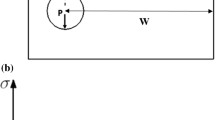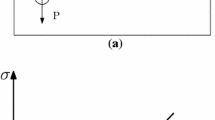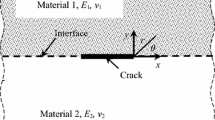Abstract
The problem of an interface crack between a shape memory alloy and an elastic layer is numerically addressed. The shape memory alloy behavior is modeled with a continuum thermodynamics based constitutive model embedded within the finite element method. With the help of the boundary layer approach, and the assumption of small scale transformation zone, the K-dominated region in the tip of the interface crack is loaded under general mixed-mode condition. Both slow and fast loading rates are considered to study the effects of thermo-mechanical coupling on the interface crack tip fields, especially the crack tip energy release rate within a history-dependent J-integral framework, the stress/strain curve during the loading process, and the shape and size of the transformation zone and the heated zone. A special effort is made to investigate how changing the rate of applied loading, the mode-mixity, and the material properties of SMA and elastic layer modify the crack tip fields.











Similar content being viewed by others
References
Ahmadian H, Hatefi Ardakani S, Mohammadi S (2015) Strain-rate sensitivity of unstable localized phase transformation phenomenon in shape memory alloys using a non-local model. Int J Solids Struct 63:167–183
Baxevanis T, Chemisky Y, Lagoudas DC (2012) Finite element analysis of the plane-strain crack-tip mechanical fields in pseudoelastic shape. Mem Alloys Smart Mater Struct 21:094012
Baxevanis T, Lagoudas DC (2012) A mode I fracture analysis of a center-cracked infinite shape memory alloy plate under plane stress. Int J Fract 175:151–166
Baxevanis T, Landis CM, Lagoudas DC (2014) On the fracture toughness of pseudoelastic shape memory alloys. J Appl Mech 81(4):041005
Birman V (1998) On mode I fracture of shape memory alloy plates. Smart Mater Struct 7:433
Boyd JG, Lagoudas DC (1996) A thermodynamical constitutive model for shape memory materials. Part I. The monolithic shape memory alloy. Int J Plast 12:805–842
Brinson LC (1993) One-dimensional constitutive behavior of shape memory alloys: thermomechanical derivation with non-constant material functions and redefined martensite internal variable. J Intell Mater Syst Struct 4:229–242
Carka D, Landis CM (2011) On the path-dependence of the J-integral near a stationary crack in an elastic-plastic material. J Appl Mech 78:011006
Carka D, McMeeking RM, Landis CM (2012) A note on the path-dependence of the J-integral near a stationary crack in an elastic-plastic material with finite deformation. J Appl Mech 79:044502
Freed Y, Banks-Sills L (2007) Crack growth resistance of shape memory alloys by means of a cohesive zone model. J Mech Phys Solids 55:2157–2180
Freed Y, Banks-Sills L, Aboudi J (2008) On the transformation toughening of a crack along an interface between a shape memory alloy and an isotropic medium. J Mech Phys Solids 56:3003–3020
Gollerthan S, Young M, Neuking K, Ramamurty U, Eggeler G (2009) Direct physical evidence for the back-transformation of stress-induced martensite in the vicinity of cracks in pseudoelastic NiTi shape memory alloys. Acta mater 57:5892–5897
Hatefi Ardakani S, Afshar A, Mohammadi S (2015a) Numerical study of thermo-mechanical coupling effects on crack tip fields of mixed-mode fracture in pseudoelastic shape memory alloys (under revision)
Hatefi Ardakani S, Ahmadian H, Mohammadi S (2015b) Thermo-mechanically coupled fracture analysis of shape memory alloys using the extended finite element method. Smart Mater Struct 24:045031
Helm D, Haupt P (2003) Shape memory behavior: modelling within continuum thermomechanics. Int J Solids Struct 40:827–849
Hu Z, Xiong K, Wang X (2005) Study on interface failure of shape memory alloy (SMA) reinforced smart structure with damages. Acta Mech Sin 21:286–293
Juhasz L, Schnack E, Hesebeck O, Andra H (2002) Macroscopic modeling of shape memory alloys under non-proportional themo-mechanical loadings. J Intell Mater Syst Struct 13:825–836
Lagoudas DC, Entchev PB (2004) Modeling of transformation-induced plasticity and its effect on the behavior of porous shape memory alloys. Part I: constitutive model for fully dense SMAs. Mech Mater 36:865–892
Lagoudas DC, Moorthy D, Qidwai MA, Reddy JN (1997) Modeling of the thermomechanical response of active laminates with SMA strips using the layerwise finite element method. J Intell Mater Syst Struct 8:476–488
Leclercq S, Lexcellent C (1996) A general macroscopic description of the thermomechanical behavior of shape memory alloys. J Mech Phys Solids 44:953–980
Maletta C, Bruno L, Corigliano P, Crupi V, Guglielmino E (2014) Crack-tip thermal and mechanical hysteresis in shape memory alloys under fatigue loading. Mater Sci Eng A 616:281–287
Maletta C, Furgiuele F (2010) Analytical modeling of stress-induced martensitic transformation in the crack tip region of nickel-titanium alloys. Acta Mater 58:92–101
Maletta C, Sgambitterra E, Furgiuele F (2013) Crack tip stress distribution and stress intensity factor in shape memory alloys. Fatigue Fract Eng Mater Struct 36:903–912
Neuser S, Michaud V, White SR (2012) Improving solvent-based self-healing materials through shape memory alloys. Polymer 53:370–378
Paiva A, Savi MA, Bragra AMB, Pachec PMCL (2005) A constitutive model for shape memory alloys considering tensile-compressive asymmetry and plasticity. Int J Solids Struct 42:3439–3457
Popov P, Lagoudas DC (2007) 3-D constitutive model for shape memory alloys incorporating pseudoelasticity and detwinning of selfaccommodated martensite. Int J Plast 23:1679–1720
Qidwai MA, Lagoudas DC (2000) On thermomechanics and transformation surfaces of polycrystalline NiTi shape memory alloy material. Int J Plast 16:1309–1343
Reese S, Christ D (2008) Finite deformation pseudo-elasticity of shape memory alloys—constitutive modelling and finite element implementation. Int J Plast 24:455–482
Robertson SW, Metha A, Pelton AR, Ritchie RO (2007) Evolution of crack-tip transformation zones in superelastic Nitinol subjected to in situ fatigue: a fracture mechanics and synchrotron X-ray micro-di raction analysis. Acta Mater 55:6198–6207
Shimamoto A, Ohkawara H, Nogata F (2004) Enhancement of mechanical strength by shape memory effect in TiNi fiber-reinforced composites. Eng Fract Mech 71:737–746
Stam G, Van der Giessen E (1995) Effect of reversible phase transformations on crack growth. Mech Mater 21:51–71
Sun QP, Hwang KC (1983a) Micromechanics modelling for the constitutive behavior of polycrystalline shape memory alloys-II. Study of individual phenomena. J Mech Phys Solids 41:19–33
Sun QP, Hwang KC (1983b) Micromechanics modelling for the constitutive behavior of polycrystalline shape memory alloys-I. Derivation of general relations. J Mech Phys Solids 41:1–17
Suo Z (1989) Mechanics of interface fracture. PhD Thesis, Harvard University, Cambridge, p 103
Wang G, Xuan F, Tu S, Wang Z (2010) Effects of triaxial stress on martensite transformation, stress-strain and failure behavior in front of crack tips in shape memory alloy NiTi. Mater Sci Eng A 527:1529–1536
Wang X, Wang Y, Baruj A, Eggeler G, Yue Z (2005) On the formation of martensite in front of cracks in pseudoelastic shape memory alloys. Mater Sci Eng A 394:393–398
Wei ZG, Tang CY, Lee W (1997) Design and fabrication of intelligent composites based on shape memory alloys. J Mater Process Technol 69:68–74
Yi S, Gao S (2000) Fracture toughening mechanism of shape memory alloys due to martensite transformation. Int J Solids Struct 37:5315–5327
Acknowledgments
The authors wish to acknowledge the technical support of the High Performance Computing Lab, School of Civil Engineering, University of Tehran. The financial support of Iran National Science Foundation (INSF) is gratefully acknowledged.
Author information
Authors and Affiliations
Corresponding author
Rights and permissions
About this article
Cite this article
Afshar, A., Hatefi Ardakani, S., Hashemi, S. et al. Numerical analysis of crack tip fields in interface fracture of SMA/elastic bi-materials. Int J Fract 195, 39–52 (2015). https://doi.org/10.1007/s10704-015-0047-9
Received:
Accepted:
Published:
Issue Date:
DOI: https://doi.org/10.1007/s10704-015-0047-9




